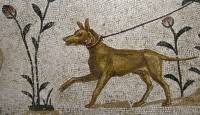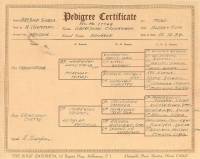What defines Purebred Dogs
 Historical Dog c 320 - 350 AD
Historical Dog c 320 - 350 AD
In 350 BC, Greek philosopher Aristotle described 'high-bred' or 'thoroughbred' domestic animals as:
'.. (coming) from noble stock, an animal is a thoroughbred if it does not deflect from its racial characteristics.
By 1486 AD dogs that displayed 'racial characteristics' which also embraced temperament for example the ability to hunt, was developed and first classified by Dame Juliana Berners in her 'Boke of Saint Albans'.
The Racial Characteristics that Define a Purebred Dog
'Racial characteristics' make purebred dogs predictable in both looks and temperament. That is because:
- The pure breed dog conforms to its Breed Standard and 'does not deflect from its racial characteristics' which defines what features are typical of the breed.
- The purebred dog must have an Official Pedigree issued and recorded in a Kennel Club or other official body
- This Official Pedigree, which is a record of the dog's parentage must be recorded in a Stud Book.
The original idea behind judging dogs at dog shows was assessing how closely the dog complied with its particular Breed Standard. The Stud Books then became vital because they recorded the dogs and their parentage responsible for these 'racial characteristics'.
1. What is a Breed Standard?
In the mid-1800's men who worked their dogs in a variety of ways formed themselves into breed associations which drew up the original Breed Standards based on the physical traits required for dog to do the job it was bred for. This shifted the focus from function to physical characteristics.
Breed specialist clubs were formed specifically for the purpose of developing the unique characteristic within a Breed Standard for their particular breed, and selecting them to define the different dog breeds we know today. Breed Standards remain the thread which holds together the fabric of the breeds.
Breed Standards have been subject to continual revision by committees of breed specialists. For example some Breed Standards have revised heights and weights in line with modern feeding which results in better bone formation, more substance, etc. Other Breed Standards have changed to accommodate modern grooming techniques. But these revisions still encompass correct breed type in the opinion of the breed specialists of the day.
2. What is a Dog's Pedigree?
 Pedigree 1937
Pedigree 1937
The pedigree is a family tree whose boughs form its genealogy. It is this family tree which possesses specialised likenesses and traits. Pedigrees typically record parentage five generations like the one shown. When each dog on the pedigree has its number recorded in an official registry or Stud Book produced by that country's Kennel Club like the one below, the dog is defined as a pure breed. These Kennel Clubs are also responsible for maintaining Breed Standards.
 ANKC Pedigree
ANKC Pedigree
Today, computer generated pedigrees produced by Kennel Clubs like the one on the right, have replaced most of the paper systems. It is important to observe the logo or symbol adopted by an organisation to officially identify itself. In this case the Australian National Kennel Council (ANKC), the logo on the top right hand corner, authenticates that this pedigree as an official record of that dog's parentage on the Australian Kennel Club registration system. Although these pedigree forms vary from country to country, there is a reciprocal arrangement between various countries.
3. What is a Stud Book?
In Britain until the late 1790's, the ancestry of all domestic animals was kept in private lists, but rarely passed on. In 1791 in Britain, the concept of publishing a 'General Stud Book' was first proposed 'to correct the evil of false and inaccurate pedigrees'. The idea was to record the ancestry of domestic animals. Although some private breeders had kept 'Lists', these were rarely passed on. Hence there was an obvious need for a published Stud Book that was a 'dictionary of facts'.
The Kennel Club was founded in 1873. The Kennel Club was set up to govern the new pastimes of dog showing and field trials. The first Kennel Club Stud Book published by 'the Field' magazine contains details of dogs which won placements at recognised shows and Field Trials between 1859 and 1863. When any breeding dog or bitch was entered in a Show, it was given a number. If the dog or bitch had a reliable pedigree, this was also recorded, some dating back many generations.
The American Kennel Club (AKC) followed one year later in 1874. with the Canadian Kennel Club (CKC) next by 1880.Then in 1911, when the Federation Cynologique Internationale ( FCI) began its operations, co-ordinating the operation of European countries.Today most countries have their own Stud Books or computer programmes to officially record pedigrees. Although mostly these are produced digitally, in effect they are still Stud Books.

